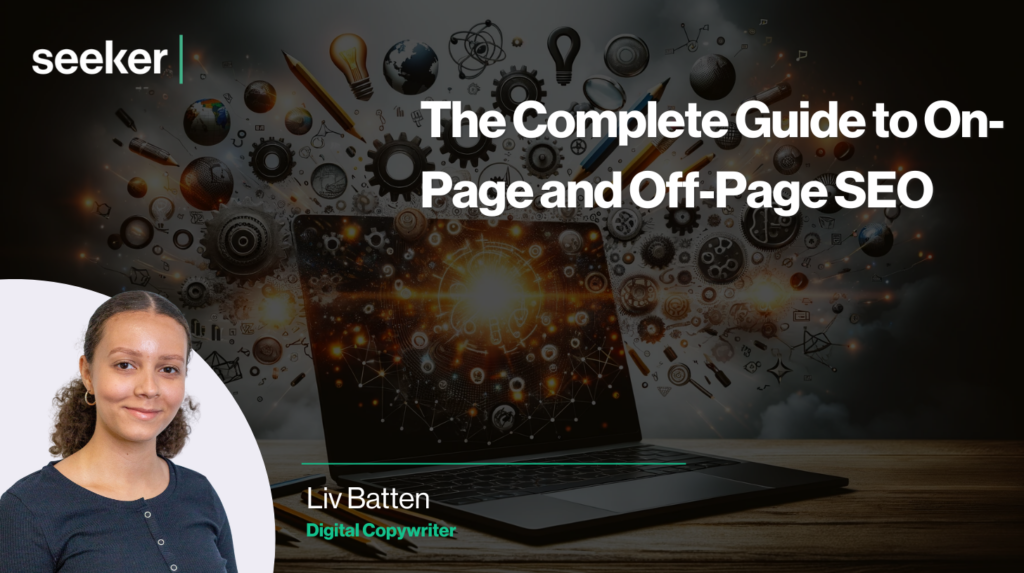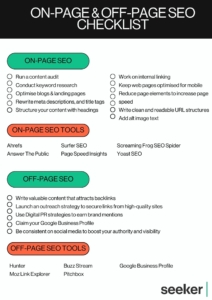
SEO is no easy field to understand, especially when the success of your online business hinges on it. Both on-page and off-page SEO are crucial for any website, and it’s important to know how these two elements differ as well as how they complement each other.
Fortunately, as seasoned SEO experts, we’re here to help you uncover the secrets of on-page and off-page SEO. From the technicalities of website optimisation to the art of building online authority, we’ll explain the main differences between on-page and off-page SEO, the crucial factors to focus on, and unravel effective strategies for both.
Let’s get started!
What’s the difference between on-page and off-page SEO?
On-page SEO focuses on optimising internal elements within your website, such as on-site content, site structure, and internal links. Conversely, off-page SEO involves external factors such as building backlinks from other websites. These backlinks act as external endorsements, enhancing your site’s authority and credibility in search engine algorithms. Both are equally essential in an SEO strategy.
What is on-page SEO?
On-page SEO involves optimising elements within your website to improve search rankings. Key practices include integrating relevant keywords into website content (such as landing page copy), writing effective SEO-friendly title tags and meta descriptions, optimising site structure, and ensuring mobile-friendliness.
But these factors aren’t just valuable in pleasing search engines; they also play a key role in your site’s overall user experience. On-page SEO is all about creating a website that’s easy to navigate, informative, and user-friendly. Nail this combination, and you’ll have happy visitors while being rewarded by Google in the SERPs.
On-page SEO is important as it:
- Ensures that your website is technically sound and user-friendly.
- Improves the relevance of your content to target keywords.
- Enhances the user experience on your site.
- Helps search engines understand the context and structure of your content.
Examples of on-page SEO factors include:
Page content
Ultimately, the content on your pages needs to be helpful. You shouldn’t be adding copy just to fill space or cram in keywords; instead, you need to be adding real value to your site, whether that’s writing detailed service pages or crafting genuinely insightful educational content.
When improving the quality of your on-page copy, this should be reflected in your on-page metrics. For example, rewriting and re-optimising an old landing page with up-to-date, valuable, and well-written content might improve your CTR (click-through rate) if you secure a featured snippet, or increase the average time spent on the page by each user. Either way, this shows Google that you’re offering a positive on-page user experience.
Keywords and optimisation
One of the cornerstones of on-page SEO is keyword research. Proper keyword research allows you to understand what your target audience is searching for and tailor your content accordingly.
The right keywords can also help you optimise other on-page areas, such as title tags and meta descriptions. All in all, utilising relevant keywords and practicing regular optimisation will keep your content valuable and help ensure it has the potential to rank for high-value search queries.
Title tags
Title tags boost on-page SEO by providing a concise and descriptive summary of a web page’s content. A compelling and relevant title tag encourages users to click on your page, and incorporating targeted keywords helps match user queries with the content of your page.
Our best practices for title tags:
- Keep them snappy at around 55-60 characters (including spaces).
- Naturally include the keywords — try to place them near the beginning of the tag.
- Include your brand at the end of the title tag, separated by a pipe bar (|). Example: “A Guide to On-Page & Off-Page SEO | Seeker Digital”
Headings (H1, H2s)
Among your on-page headings, your main heading (H1) holds the most SEO weight and it establishes the primary topic of the page, so it’s a good idea to include your target keywords here, and also in your subheadings (H2s and H3s).
Headings also make your content easier to digest by readers, as they help to break up the content and make it scannable, but it’s equally important for helping search engine crawlers to understand the content as they scan the page for relevancy.
URL structure
On-page SEO also includes your URL structure. A clean and readable URL structure enhances the user experience, as users can quickly grasp what the page is about by looking at the URL. However, a clear URL with relevant keywords also ensures that search engines index your pages correctly.
A few pointers on creating SEO-friendly URLs:
- Include keywords into your URLs if possible, but be careful when changing existing URLs, unless you plan on redirecting your old ones to your new ones.
- Ensure your URLs are not too long.
- Avoid the use of special characters in your URLs.
- Use lowercase letters and hyphens, not underscores.
Alt text for images
Alt text often gets overlooked, but it’s an important factor for delivering a good user experience. This text isn’t visible to the average visitor — instead, alt text is used by screen reader software to help visually impaired users understand the context of your images.
Search engines similarly crawl images, so inserting relevant keywords into your alt text will help search engines understand your page’s visual content.
Our tips for writing effective image alt text:
- Provide a concise and accurate description of the image.
- Consider the context of the image within the surrounding content.
- Integrate keywords in a way that feels natural and doesn’t compromise the clarity and accuracy of the image description.
Page load speed & mobile friendliness
Both page speed and mobile-friendliness are integral components of on-page SEO, as Google prioritises fast-loading and mobile-first indexing.
Using tools like Google’s PageSpeed Insights helps you understand your average loading speeds on both desktop and mobile devices, while also suggesting ways to resolve bottlenecks and reduce latency. You can also use Google’s Mobile Usability Report to identify any issues your website may have specifically for mobile users.
When it comes to page speeds and mobile responsiveness, consider the following:
- Choose a responsive web design that ensures your website adapts to various screen sizes and devices.
- Compress and resize images (your website should have no images larger than 20MB).
- Simplify navigation menus and remove any unnecessary content.
- Reduce the number of elements (images, scripts, stylesheets) on each page.
- Ensure buttons and CTAs are easily clickable using a finger or thumb.
Internal Linking
Why is internal linking crucial in on-page SEO? Well, internal links help users navigate your website, but they also make it easier for crawlers to index new pages and understand the hierarchy between them.
Our internal linking tips and tricks:
- Use relevant keywords in your anchor text (the text that includes your hyperlink) to signal the topic and relevance of the linked content.
- Ensure your links are contextually relevant to the content of the current page.
- Regularly audit your internal links to identify and fix broken links.
What is off-page SEO?
Unlike on-page SEO, which involves optimising elements directly on the website, off-page SEO focuses on external factors that influence the site’s authority and credibility. While website owners have less direct control over off-page SEO, there are factors, such as securing backlinks and improving your social proof, that can improve your optimisation in this area.
Off-page SEO is important as it:
- Builds trust and credibility with search engines.
- Influences the perception of your brand in the online community.
- Generates external signals of your website’s popularity and relevance.
- Contributes to the overall online presence and visibility of your brand.
Examples of off-page SEO factors include:
Backlinks
Backlinks are a fundamental aspect of off-page SEO. They signal to Google that your content is credible and over time, this positively affects your website’s ‘domain authority’ as well as its organic search results.
However, it’s important to consider that not all backlinks are created equal; links from reputable, industry-relevant websites carry more weight, and this means actively seeking opportunities for relevant, high-quality links.
Our tips for effective link building include the following:
- Create high-quality, valuable content that naturally attracts backlinks from other websites.
- Launch an SEO outreach strategy to secure targeted links from high-quality sites.
- Seek backlinks from a diverse range of sources, including blogs, industry publications, and reputable websites within your niche. This is a sign of natural, organic growth.
Mentions
While direct backlinks are valuable for off-page SEO, brand mentions provide additional signals of credibility, authority, and relevance. It’s important to monitor and manage your brand mentions, ensuring that they contribute positively to your online reputation and overall SEO strategy.
To manage your mentions successfully, remember the following:
- Produce high-quality, shareable content that stands out in your industry. Valuable and unique content is more likely to be mentioned and shared by others.
- Implement a Digital PR strategy by sharing press releases, noteworthy achievements, or interesting stories to increase the chances of media coverage and mentions.
- Use tools like Google Alerts, social media monitoring tools, or advanced SEO platforms to track brand mentions.
Google Business Profile
Having an active Google Business Profile is an essential component of developing your off-page SEO — as well as your local SEO, which is crucial for brands with physical premises or location-specific services. Reviews, mentions, and business information on your profile all enhance your overall online visibility, credibility, and relevance in local search results.
A few tips for optimising your Google Business Profile:
- Fill out every section of your Google Business Profile with accurate and detailed information, including your business name, address, phone number, business hours, and website.
- Respond promptly and professionally to customer reviews, both positive and negative.
- Geo-tag your photos to provide additional location-based information to users and improve the local relevance of your profile.
Social media
Social media is perhaps one of the most important channels to build your off-page SEO. These platforms are a place to build your brand, and all of these efforts will contribute to your off-page SEO — particularly since social media posts and pages can actually appear in search results.
A strong social presence can be an indirect signal of your website’s popularity and relevance, so it’s important to consistently engage with your audience. Positive brand mentions across social channels will also contribute to the overall reputation and trustworthiness of your brand.
Some social media pointers for SEO:
- Regularly post engaging, relevant, and high-quality content on your social media platforms.
- Collaborate with social media influencers in your niche.
- Incorporate trending and relevant hashtags in your posts to increase the visibility of your content.
- Actively promote your blog posts, articles, or web pages on social media. This drives direct traffic to your content.
Is on-page SEO or off-page SEO more important?
Both on-page SEO and off-page SEO are crucial components of a comprehensive search engine optimisation strategy — you can’t have one without the other. On-page and off-page work in tandem: on-page SEO makes your site accessible to search engines and users, while off-page SEO enhances its reputation and visibility in the broader digital landscape.
Neglecting either aspect can limit your website’s potential to rank well in search engine results, and so the best approach is to aim for a well-balanced combination of both on-page and off-page optimisation.
Seeker’s on-page & off-page SEO checklist

Understanding on-page and off-page SEO is the first step in improving your overall SEO strategy. These two approaches are equally crucial, working simultaneously to enhance your site’s crawlability, user experience, and overall ranking potential.
If you’re looking for a Bristol digital marketing agency to support both your on-page and off-page SEO efforts, get in touch with Seeker today!
